Technical description
The Metis optical design is dictated by the need to minimize the entrance aperture of the instrument, located at the level of the thermal shield, in order to reduce the thermal flux input.
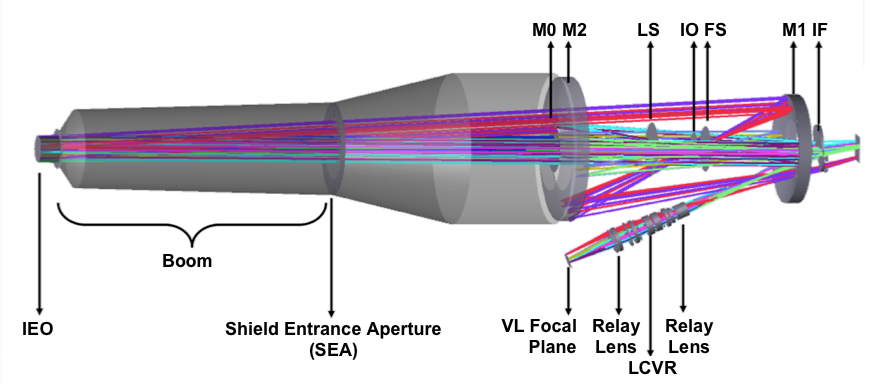
Metis optical concept, describing the light path from the entrance aperture to the interference filter (IF). The ultraviolet (UV) light is then focused on the UV detector. The visible light (VL) reflected by the filter crosses the polarimeter and is focused on the VL detector
The disk light entering through the aperture is rejected outwards by the reflecting mirror M0. Whilst the coronal light reaches the primary mirror, M1, and is reflected on the secondary mirror M2. This mirror then focuses the light on the ultraviolet (UV) detector forming the image of the UV corona. The visible component of the light is instead reflected by a filter positioned between M2 and the UV detector. A liquid crystal polarimeter, positioned between the filter and the visible light detector selects the polarized light, namely the photospheric light scattered by the coronal electrons. Thus the visible light detector images only the true coronal light.
The distance from Sun center of the coronal ring imaged by Metis depends on the position of Solar Orbiter along its orbit. At minimum perihelion — the point of closest approach to the Sun — Metis acquires annular images of the solar corona between 1.7 and 3.1 R☉ (solar radii) from disk center.
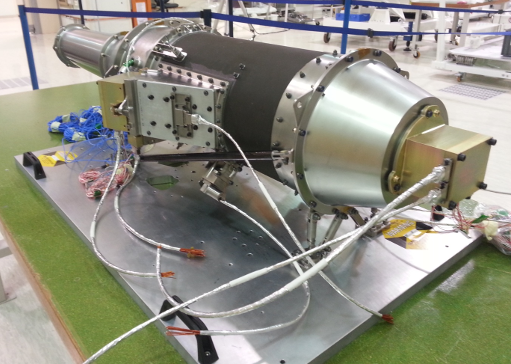
Metis structural model ready for the vibration test campaign (courtesy of Thales Alenia Space Italia)
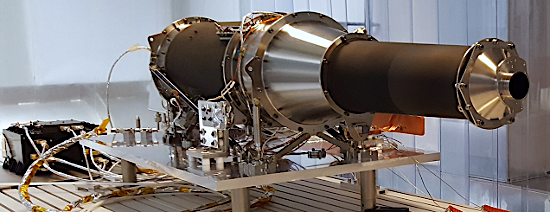
Metis flight telescope and processing & power unit, April 2017 (courtesy of Thales Alenia Space Italia)
Optical layout
Metis is an externally occulted coronagraph. The advantage of an externally occulted coronagraph to observe the extended solar corona is given by the need of reducing the large dynamic range of the coronal signal that decreases exponentially from the limb to the outer corona. The highly vignetted aperture of the externally occulter coronagraph at lower heliocentric height compensates in part the high dynamic range, making possible the observation of the corona at higher heights. The occultation scheme is based on an inverted external-occulter (IEO).
The inverted external occulter (IEO) consists of a circular aperture (ø 40 mm) (entrance pupil of the instrument) at the narrow end of a truncated cone (for stray light optimization) kept by a boom at 800 mm in front of the telescope. The disk light through the IEO is rejected back by a spherical heat-rejection mirror (M0 — ø 71 mm) up to 1.1° (i.e., 1.17 R☉ at 0.28 AU). The coronal light, on the other hand, is collected by an on-axis Gregorian telescope. The suppression of the diffracted light off the edges of the IEO and M0 is achieved, respectively, with an internal occulter (IO) and a Lyot stop (LS).
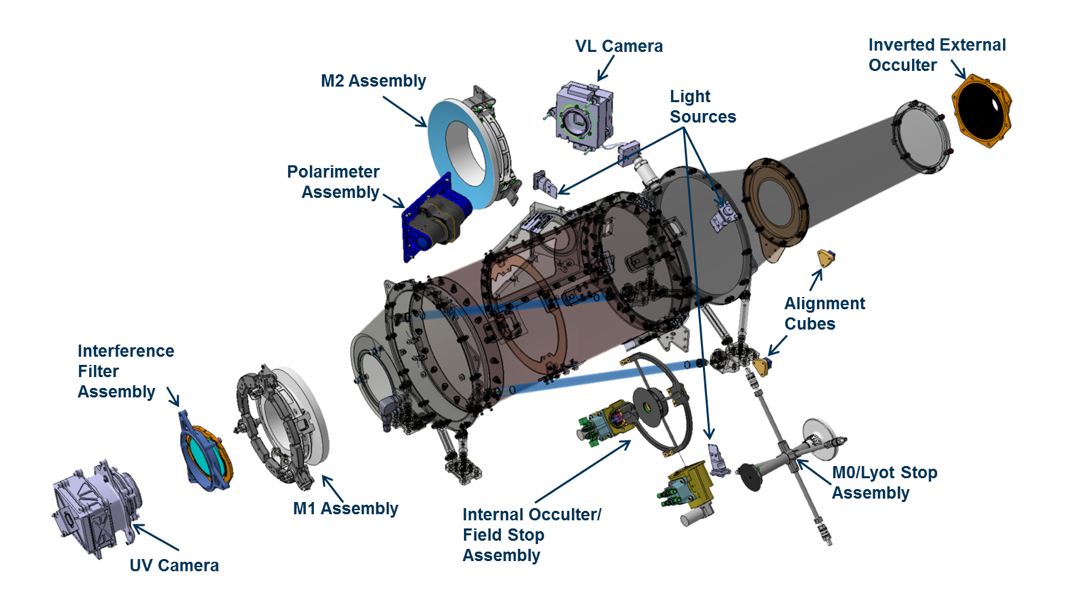
Metis opto-mechanical design (courtesy of Thales Alenia Space Italia)
The main motivation of adopting the original inverted-occultation scheme has been the need to reduce the thermal load in the instrument during perihelion operations. A classical externally-occulted coronagraph has an annular aperture defined by the entrance aperture and the outer edge of a disk that acts as external occulter. The telescope objective optics is in the shadow of the external occulter disk. For the same light-collecting area, a classical externally-occulted coronagraph requires an (annular) disk-light rejecting mirror that is much larger than the (circular) one used in the inverted-occultation scheme adopted for Metis. This reduces considerably (by two orders of magnitude) the thermal load on the rejection mirror.
The visible-light (VL) and UV paths are split by a UV interference filter at 12° angle of inclination with respect to the optical axis. The MgF2/Al coatings in the primary (M1) and secondary (M2) telescope mirrors are optimized for enhanced reflectivity at 121.6 nm. The coating has also high reflectivity in the VL (580–640 nm). The UV narrow bandpass interference filter acts as VL-UV beam splitter by selecting the 121.6 nm UV band in transmission and reflecting the VL to the polarimeter. Inside the polarimeter, a broad-band filter selects the VL bandpass (580–640 nm).
The external occultation design advantages are that the telescope observes up to higher heliocentric heights, several solar radii, because the external occulter rejects the solar disk light in a more efficient way; in addition to that, the vignetting effect of the external occulter varies gradually the aperture of the telescope from zero, at the bottom end of the field of view (FOV) to a maximum value, at the top end of the FOV.
Polarimeter
Metis visible-light polarimeter is designed to measure the linearly polarized solar K-corona in the VL band with a sensitivity to the fractional linear polarization measurement (i.e., minimum detectable linear polarization) better than or equal to 0.01.
The VL path polarimeter consists of a polarimetric group (PG) and a relay-optics system (ROS). The ROS collimates, through the PG, the light from the image formed by the telescope on the intermediate VL focal plane. Then the ROS re-focuses the image on the VL detector, with a 1:0.67 demagnification ratio to match the telescope plate scale with the APS pixel size. The PG electro-optically modulates the intensity of the linearly polarized K-corona. The PG is comprised of polarization optics in “Senarmont configuration”:
- bandpass (BP) filter (580–640 nm);
- fixed quarter-wave (QW) retarder;
- Polarization Modulation Package (PMP) with Liquid Crystal Variable Retarder (LCVR) double-cell;
- linear polarizer (LP).
The estimated instrumental polarization of the polarimeter is lower than (5±1)×10-2.
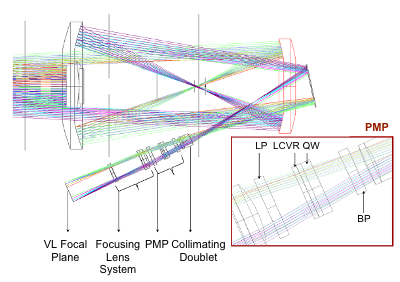
Optical layout of the VL path and details of the polarimeter
Detectors
The UV and VL detectors are, respectively, an intensified active pixel sensor (IAPS) with scale factor 20 arcsec/pixel and image size of 30.7 mm (1024×1024) with 30-µm equivalent pixel size; and an APS with scale factor 10 arcsec/pixel and image size of 20.5 mm (2048×2048) with 10-µm pixel size.
Metis instrument performances
The following table summarizes the Metis top-level instrument performance aimed at satisfying the top-level observational requirement. Futher information can be found in the Metis paper on the Solar Orbiter mission book.
| CORONAL IMAGING | |||
|---|---|---|---|
| Wavelength Range | VL | 580–640 nm | |
| UV | 121.6±10 nm | ||
| Effective Focal Length | VL | 200 mm | |
| UV | 300 mm | ||
| Spatial Plate Scale | VL | 10 arcsec | |
| UV | 20 arcsec | ||
| Field of View(1) | 1.6°–2.9° | = 1.7–3.1 R☉ at 0.28 AU | |
| = 3.0–5.5 R☉ at 0.5 AU | |||
| Average Instrumental Stray-light(2) | VL | Bstray/B☉ < 10-9 | |
| UV | Bstray/B☉ < 10-7 | ||
| Temporal Resolution | VL | 1–450 s | |
| UV | 1–30 min | ||
| Broad‑band Linear Polarization Sensitivity | ≤ 10-2 | ||
| Signal to Noise Ratio | VL | > 7 (7-590) | |
| UV | > 3 (3-86) | ||
| GENERAL | |||
| Telemetry Rate | 10.5 kbit/s | ||
| Data Volume(3) | 27.2 GB/orbit | ||
| 1 Annular, off-limb corona | |||
| 2 Stray-light to solar disk irradiance ratio ≡ Bstray/B☉ | |||
| 3 With a compression ratio up to 10 | |||